DOS/V
DOS/V is a Japanese computing initiative starting in 1990 to allow DOS on IBM PC compatibles with VGA cards to handle double-byte (DBCS) Japanese text via software alone.[1] It was developed by IBM for its PS/55 machines (a localized version of the PS/2).[1] Kanji fonts and other locale information are store on the hard disk rather than on special chips as in the preceding AX architecture. As with AX, its great value for the Japanese computing industry is in allowing compatibility with foreign software. This had not been possible under NEC's proprietary PC-98 system, which was the market leader before DOS/V emerged. DOS/V stands for "Disk Operating System/VGA" (not "version 5"; DOS/V came out at approximately the same time as DOS 5). An IBM PC compatible computer is often referred to as "DOS/V machine" or "DOS/V pasocom" in Japan even if it doesn't ship with DOS/V.[2]
 | |
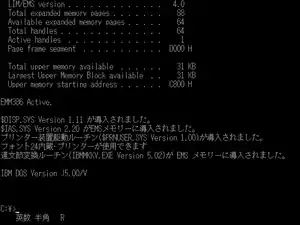 Screenshot of IBM DOS J5.0/V | |
| Developer | IBM and Microsoft |
|---|---|
| Written in | Assembly language, C |
| OS family | DOS |
| Working state | No longer supported |
| Source model | Closed source |
| Initial release | November 1990 |
| Latest release | PC DOS 2000 / July 1998 |
| Available in | Japanese, Taiwanese, Chinese, Korean |
| Platforms | x86 |
| Kernel type | Monolithic kernel |
| Default user interface | Command-line interface |
| License | Commercial proprietary software |
The promotion of DOS/V was done by IBM and its consortium called PC Open Architecture Developers' Group (OADG).[1]
Digital Research released a Japanese DOS/V compatible version of DR DOS 6.0 in 1992.[3][4]
History
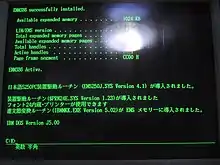
In early 1980s, IBM Japan developed two x86-based personal computer lines for Asian-pacific region, IBM 5550 and IBM JX. The 5550 reads kanji fonts from the disk, and draws text as graphic characters on 1024×768 high resolution monitor. The JX extends IBM PCjr and IBM PC architecture. It supports English and Japanese versions of PC DOS with 720×512 resolution monitor. Both machines couldn't break dominant NEC's PC-98 in consumer market in Japan. Because the 5550 was expensive, it was mostly sold for large enterprises who used IBM's mainframe . The JX used 8088 processor instead of faster 8086 processor because IBM thought a consumer-class JX mustn't surpass a business-class 5550.[5] It damaged buyer's reputations whatever the actual speed was. In another point, a software company said IBM was uncooperative for developing JX software.[6] IBM Japan planned a 100% PC/XT compatible machine codenamed "JX2", but it was cancelled in 1986.[5][7]
Masahiko Hatori(羽鳥 正彦) was a developer of JX's DOS. In 1987, he started developing the DOS/V during spare time at IBM Yamato Development Laboratory. In this era, Toshiba released the J-3100 laptop computer, and Microsoft introduced the AX architecture. IBM Japan didn't join in the AX consortium. His boss, Tsutomu Maruyama(丸山 力), thought IBM 's headquarters wouldn't allow to adopt the AX because they requested IBM Japan to use the same standard as worldwide IBM offices used.[8] In October 1987, IBM Japan released the PS/55 model 5535 which was a proprietary laptop using a special version of DOS. It was more expensive than the J-3100 because its LCD display used a non-standard 720×512 resolution. Hatori thought IBM needed to shift their own proprietary PC to IBM PC compatibles. Maruyama and Nobuo Mii thought Japan's closed PC market needed to be changed and this attempt couldn't be done by IBM alone. In summer of 1989, they decided to carry out the development of DOS/V, disclose the architecture of PS/55, and found the PC Open Architecture Developers' Group (OADG).[9]
The DOS/V development team designed the DOS/V to be simple for better scalability and compatibility with original PC DOS. They had difficulty reducing text drawing time. "A stopwatch was a necessity for DOS/V development", Hatori said.[10]
IBM Japan announced the first version of DOS/V, IBM DOS J4.0/V, on October 11, 1990, and shipped out in November 1990. At the same time, IBM Japan released PS/55 model 5535-S, a laptop computer with VGA. The announcement letter said DOS/V was designed for low-end desktops and laptops of PS/55,[11] but users reported on BBS that they could run DOS/V on IBM PC clones.[12] The development team unofficially confirmed these comments, and modified incompatibilities of DOS/V. It was a secret inside the company because it would prevent sales of PS/55 and meet with opposition. Hatori said,[9]
We hid the DOS/V run on other IBM compatible machines. The fact was that we developed it could run on Gateway's and any machines, but we had to keep the secret, not to spread it, because there are lots of enemies inside the company. In short, it was a double-edged sword. If the DOS/V run on such cheap compatible machines, conversely the 5550 series which had taken high profit up may not be sold. In fact, 80% of staff in Yamato office opposed it.
Maruyama and Mii had to convince IBM's branches to agree with the plan. In the beginning of December 1990, Maruyama went to IBM's Management Committee, and presented his plan "The low-end PC strategy in Japan". At the committee, a topic usually took 15 minutes, but his topic took an hour. The plan was finally approved by John Akers.[9]
After the committee, Susumu Furukawa, a president of Microsoft Japan, could make an appointment with IBM Japan to share the source code of DOS/V.[13] On December 20, 1990, IBM Japan announced they founded OADG and Microsoft would supply DOS/V for other PC manufacturers. From 1992 to 1994, many Japanese manufacturers began selling IBM PC clones with DOS/V. Some global PC manufacturers entered into the Japanese market, Compaq in 1992 and Dell in 1993. Fujitsu released IBM PC clones (FMV series) in October 1993, and about 200,000 units were shipped in 1994.[14]
In 1992, IBM Japan released the PS/V (similar to the PS/ValuePoint, but not identical) and the ThinkPad. They were based upon an architecture closer to PC compatibles, and intended to compete with rivals in the consumer market. As of December 1992, the PS/V was the most selling DOS/V computer.[15] In January 1993, NEC released a new generation of the PC-98 to take back its initiative. NEC advertised that the scrolling speed of the word processor Ichitaro on the PC-9801BX was faster than on the PS/V 2405-W.[16] Yuzuru Takemura(竹村 譲) of IBM Japan said, "Let us suppose the movement towards Windows is inevitability. Processors and graphics cards will become faster and faster. If the PC-98 holds its architecture, it never beat our machine at speed. Windows is developed for the PC/AT architecture. Kanji glyphs are also supplied as a software font. The only thing IBM have to do is tuning up it for the video card. On the different architecture, it will be hard to tune up Windows".[5]
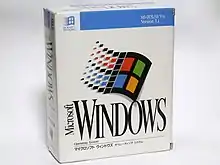
In 1993, Microsoft Japan released first retail versions of Windows (Windows 3.1) for both DOS/V and PC-98. The DOS/V contributed the dawn of IBM PC clones in Japan, yet PC-98 had kept 50% of market share until 1996.[17] It was turned round by the release of Windows 95.
Drivers
Versions

In 1988, IBM Japan released a new model of the PS/55 which was based on the PS/2 with Japanese language support. It is equipped with a proprietary video card which has a high resolution text mode and a Japanese character set stored in a ROM on the card. It supports Japanese DOS K3.3, PC DOS 3.3 (English) and OS/2.[22]
IBM DOS J4.0 was released in 1989.[23] It combines Japanese DOS and PC DOS, which runs Japanese DOS as the Japanese mode (PS/55 mode) and PC DOS as the English mode (PS/2 mode). Although it had two separated modes that needed a reboot to switch between them, IBM Japan called it bilingual. This version requires the PS/55 display adapter.
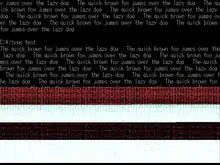
The first version of DOS/V, IBM DOS J4.0/V (J4.05/V), was released in the end of 1990. The word 'DOS/V' was quickly known to Japanese computer industry, but the DOS/V itself didn't spread quickly. As of 1991, some small companies sold American or Taiwanese computers in Japan, but DOS J4.0/V caused some issues on PC compatibles.[24] Its EMS driver can use for the PS/55 only. The input method doesn't support a US English layout keyboard nor a Japanese AX keyboard, so it locates some keys at the wrong place. Scrolling text with the common Tseng Labs ET4000 graphics controller makes the screen unreadable. This issue can be fixed by the new '/HS=LC' switch of $DISP.SYS in DOS J4.07/V.[7][25][26] mentions that "some VGA clones did not correctly implement the CRTC address wraparound. Most likely those were Super VGAs with more video memory than the original VGA (i.e. more than 256K). Software relying on the address wraparound was very rare and therefore the functionality was not necessarily correctly implemented in hardware. On the other hand, the split screen technique was relatively well documented and well understood, and commercial software (especially games) sometimes used it. It was therefore likely to be tested and properly implemented in hardware."
IBM Japan released DOS J5.0/V in October 1991, and DOS J5.0 in December 1991.[27] DOS J5.0 combines Japanese DOS and DOS/V. This is the last version developed for the PS/55 display adapter. DOS J5.02/V was released in March 1992.[28] It added support for the IBM PS/2 and a US English layout keyboard.
The development of MS-DOS 5.0/V was delayed because IBM and Microsoft disputed how to implement the API for input methods. It took a few months to make an agreement that the OEM adaptation kit (OAK) of MS-DOS 5.0/V provided both IAS (Input Assist Subsystem) and MKKC (Microsoft Kana-Kanji Conversion). Microsoft tried to add the AX applications support into DOS/V, but it was cancelled due to its speed. Some PC manufacturers couldn't wait Microsoft's DOS/V. Toshiba developed a DOS/V emulator that could run DOS/V applications on a VGA-equipped J-3100 computer. AST Research Japan and Sharp decided to bundle IBM DOS J5.0/V. Compaq developed own DOS/V drivers, and released their first DOS/V computers in April 1992.[29][30]
On December 10, 1993, Microsoft Japan and IBM Japan released new versions of DOS/V, MS-DOS 6.2/V Upgrade and PC DOS J6.1/V.[31] Although both were released at the same time, they were separately developed.[32] MS-DOS 6.2/V Upgrade is the only Japanese version of MS-DOS released by Microsoft under its own brand for retail sales. Microsoft Japan continued selling it after Microsoft released MS-DOS 6.22 to resolve patent infringement of DoubleSpace disk compression.[33]
IBM Japan ended support for PC DOS 2000 on January 31, 2001,[34] and Microsoft Japan ended support for MS-DOS on December 31, 2001.[35]
Japanese versions of Windows 2000 and XP has a DOS/V environment on NTVDM. It was removed in Windows Vista.[36]
PC DOS versions
PC DOS versions of DOS/V (J for Japanese, P for Chinese (PRC), T for Taiwanese, H for Korean (Hangul)):[37]
- IBM DOS J4.0/V "5605-PNA" (version 4.00 – 4.04 were not released for DOS/V)[38]
- IBM DOS J5.0/V "5605-PJA" (1991-10),[41][39][38] IBM DOS T5.0/V,[41] IBM DOS H5.0/V[41]
- PC DOS J6.1/V "5605-PTA" (1993-12),[41][39][38] PC DOS P6.1/V,[41] PC DOS T6.10/V
- PC DOS J6.3/V "5605-PDA" (1994-05)[41][39][38]
- PC DOS J7.0/V "5605-PPW" (1995-08),[39][37][38] PC DOS P7/V,[37] PC DOS T7/V,[37] PC DOS H7/V[37]
- PC DOS 2000 Japanese Edition "04L5610" (1998-07)[39][38][34]
 IBM DOS J5.02/V
IBM DOS J5.02/V
MS-DOS versions
MS-DOS versions of DOS/V:
- Toshiba Nichi-Ei (日英; Japanese-English) MS-DOS 5.0[29]
- Compaq MS-DOS 5.0J/V (1992-04)[30]
- Sony MS-DOS 5.0/V (contains Compaq MS-DOS 5.0/V)
- MS-DOS 5.0/V (OEM, generic MS-DOS 5.0/V)
- MS-DOS 6.0/V
- MS-DOS 6.2/V (Retail, 1993–12)[38]
- MS-DOS 6.22/V (1994-08)
- Fujitsu Towns OS for FM Towns (only late issues had DOS/V compatibility added)
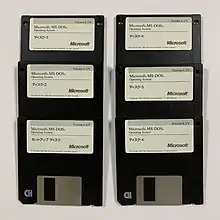 Japanese MS-DOS 6.2/V floppy disks
Japanese MS-DOS 6.2/V floppy disks MS-DOS 6.2/V
MS-DOS 6.2/V
DR DOS versions
DR DOS versions of DOS/V:
- DR DOS 6.0/V (Japanese) (1992-07),[nb 1][3][4][42][38] DR DOS 6.0/V (Korean)[nb 1]
- Novell DOS 7 (Japanese)?[nb 3][44]
- (DR-DOS 7.0x/V) (2001-2006) (an attempt to build a DR-DOS/V from existing components)[45]
Extensions
IBM DOS/V Extension extends DOS/V drivers to set up a variety of text modes for certain video adapters. The High-quality Text Mode is the default 80 columns by 25 rows with 12×24 pixels large characters. The High-density Text Mode (Variable Text; V-Text) offers large text modes with various font sizes. DOS/V Extension V1.0 included drivers for VGA, XGA, PS/55 Display Adapter, SVGA (800×600) and ET4000 (1024×768).[46] Some of its drivers were included in PC DOS J6.1/V and later.
See also
- Unicode
- List of DOS commands
- Kanji CP/M-86 (1984)
- DOS/V Power Report (A Japanese magazine on DOS/V)
Notes
- Japanese and Korean issues of the DR DOS ANSI.SYS driver contain support for a number of special arguments to switch to Japanese video modes and toggle between Korean and English input modes.
- A Japanese version of Novell NetWare Lite named "NetWare Lite 1.1J" existed for four Japanese platforms: DOS/V, Fujitsu FM-R, NEC PC-98/Epson PC and Toshiba J-3100. DOS/V-related updates were distributed by Novell as DOSV6.EXE, DOSV.EXE, TSBODI.LZH and were supported up to 1997.
- A Japanese version of Novell DOS 7 was announced and is referred to in various English documents, but was apparently never released.
- A Japanese version of Novell Personal NetWare 1.0 named "Personal NetWare J" existed for four Japanese platforms: DOS/V, Fujitsu FM-R, NEC PC-98/Epson PC and Toshiba J-3100, some of which were distributed by CONTEC. DOS/V-related updates were distributed by Novell as P10J0?.EXE (with ? replaced by 1 - 5), PNDOSV2.EXE, PNDOSV1.LZH and were supported up to 1995.
References
- Boyd, John (April 1997). "From Chaos to Competition - Japan's PC industry in transformation". Computing Japan Magazine. Archived from the original on 2017-01-16. Retrieved 2017-01-16.
- "DOS/Vとは - IT用語辞典". IT用語辞典 e-Words (in Japanese). Incept Inc. 2016-05-07. Retrieved 2020-11-05.
- 土井, 誠二 (1992). DR DOS 6.0/V 試用レポート. ASCII (in Japanese). 16 (9): 238–240. ISSN 0386-5428.
- Wein, Josef "Joe" (2012) [2003]. "Resume: Joe Wein". Archived from the original on 2017-09-10. Retrieved 2017-09-10.
[…] [up to] 1992 Digital Research GmbH […] DR DOS 6.0 […] Japanese input support for Japanese version of DR DOS. […]
- "Special Interview キーマンが語る: 日本IBM情報システム(株) 竹村譲 氏、日本IBM(株) 羽鳥正彦 氏" [Special Interview : Key persons talks : IBM Japan Information System, Joe Takemura and IBM Japan, Masahiko Hatori]. ザ・ベーシック. 技術評論社. 120: 33–40. 1993.
- "戦略研究 パソコンビジネス―日本IBM". 日経パソコン. Nikkei McGraw-Hill. 1986-02-10: 180–184. ISSN 0287-9506.
- Hatori, Masahiko. "WingBird Lab. by M.hatori: DOS/V". Archived from the original on 2002-01-06. Retrieved 2018-06-21.
- 関口, 和一 (2000). パソコン革命の旗手たち (in Japanese). Nihon Keizai Shimbun. p. 271. ISBN 4-532-16331-5.
- "DOS/V 5周年 実録 日本アイ・ビー・エム物語" [5th Anniversary of DOS/V : Report : The story of IBM Japan]. Asahiパソコン. Asahi Shimbun. 1995-04-01: 142–152. ISSN 0916-0302.
- Hatori, Masahiko. "DOS/V architecture" (in Japanese). Archived from the original on 1999-05-03. Retrieved 2018-06-25.
- IBM Japan (1990-10-11). PS/55に業界最高速モデル登場 [The industry's fastest model is now added on PS/55]. Jōhō Kagaku 情報科学 (in Japanese). ja:情報科学研究所 (published 1991). 27: 53–61. ISSN 0368-3354. Retrieved 2018-06-29.
- MIXハイライト : ibm.pc 会議 : PC/AT互換パソコンでDOS/Vが動いた [MIX highlights : ibm.pc forum : I found the DOS/V could run on PC/AT compatibles]. Nikkei Baito = Nikkei Byte 日経バイト (in Japanese). Nikkei Business Publications: 326–329. January 1991. ISSN 0289-6508. Retrieved 2020-03-06.
- Furukawa, Susumu (2015). 僕が伝えたかったこと、古川享のパソコン秘史. Japan: Impress R&D. ISBN 978-4-8443-9700-7.
- "戦略研究 富士通". 日経パソコン. Nikkei Business Publications. 1994-10-10: 166–173. ISSN 0287-9506.
- 渡辺, 和博. "NPCレポート マーケット: 急速に立ち上がったDOS/Vパソコン市場". 日経パソコン (in Japanese). Nikkei Business Publications. 1993-03-01: 142–148. ISSN 0287-9506.
- "特集 : 追う98、追われる98". 日経パソコン (in Japanese). Nikkei Business Publications. 1993-03-15: 130–145. ISSN 0287-9506.
- "96年度パソコン国内出荷台数、前年度比29.7%増―マルチメディア総研". Nikkei Sangyo Shimbun. 1997-04-24. p. 9.
- "$FONT.SYS". PC Users' Guide Forums (FPCU). Retrieved 2017-01-15.
- Myers, Steven; Smith, Greg (March 1995). "DOS/V: The Soft(ware) Solution to Hard(ware) Problems". Computing Japan Magazine. Archived from the original on 2017-01-15. Retrieved 2017-01-15.
- Cha. N. (2012-10-21). "DOS/V - FONTX - Electronics Projects". Archived from the original on 2017-01-10. Retrieved 2017-01-15.
- "$DISP.SYS". PC Users' Guide Forums (FPCU). Retrieved 2017-01-15.
- "特集 最新機種レポート'88:PS/2互換の日本語マシン 日本アイ・ビー・エム IBMパーソナルシステム/55 モデル5550-S/T モデル5570-T". ASCII (in Japanese). ASCII. 12 (7): 158–161. 1988. ISSN 0287-9506.
- "ASCII EXPRESS : 第68回ビジネスショウ". ASCII (in Japanese). ASCII. 13 (7): 231. 1989. ISSN 0287-9506.
- 永沼, 成子. "How to パソコン: AT互換機でDOS/V動かす". 日経パソコン (in Japanese). Nikkei Business Publications. 1991-09-16: 278–284. ISSN 0287-9506.
- "退廃的互換機趣味(其之二十)【ET4000】". Schwarzschild Cafe (in Japanese). 2009-06-05. Retrieved 2020-11-02.
- 長浜, 和也 (2018-08-15). "「大和研究所は憎悪の対象だった」――初代IBM PC開封の儀で明らかになった「ThinkPad誕生の奇跡」". ITmedia PC USER (in Japanese). Retrieved 2020-11-01.
- "ソフト新製品: IBM OS/2 J2.0とDOS 5.0/V". Interface (in Japanese). CQ Publishing Co., Ltd. 17 (12): 302. ISSN 0387-9569.
- "ニューズレター: 米IBM、DOS/Vの販売とサポートを開始". 日経パソコン (in Japanese). Nikkei Business Publications. 1992-03-30: 44. ISSN 0287-9506.
- 星野, 友彦 (1991). "トレンド: 離陸準備を完了したDOS/Vマシン、ゴー・サイン点灯は来春か". 日経バイト (in Japanese). Nikkei Business Publications. 93: 154–167. ISSN 0289-6508.
- "ASCII EXPRESS : コンパックが日本市場に参入、5機種25モデルを発売". ASCII (in Japanese). ASCII. 16 (4). 1992. ISSN 0287-9506.
- "マイクロソフト、MS-DOS最新版、自社ブランドで発売。". Nikkei Sangyo Shimbun (in Japanese). 1993-12-07. p. 6.
- 本間, 健司 (1993). "バイト・レポート : MSと日本IBMが異なる新DOS/Vを発売へ". 日経バイト (in Japanese). Nikkei Business Publications. 118: 94. ISSN 0289-6508.
- 鈴木, 直美 (2002-01-22). "鈴木直美の「PC Watch先週のキーワード」". pc.watch.impress.co.jp (in Japanese). Impress Corporation. Retrieved 2020-10-30.
- "IBM PC DOS 2000 日本語版 および 英語版 の発表". www-01.ibm.com (in Japanese). 1998-06-10. Retrieved 2020-09-18.
- "デスクトップ オペレーティングシステム(OS)の提供およびサポートの提供期間に関するガイドライン" (in Japanese). Microsoft Corporation. 2001-09-07. Archived from the original on 2001-11-08. Retrieved 2020-10-30.
- 及川, 卓也 (2006-06-16). "Windows Vista における 16 ビットサポート" (in Japanese). Archived from the original on 2006-07-01. Retrieved 2020-10-31.
- "SurePOS 100 IBM 4613 Point of Sale Terminal Technical Reference" (PDF). 1.0. IBM Corporation. 2007-12-31 [2001]. Archived from the original (PDF) on 2016-08-06. Retrieved 2017-01-16.
- "Timeline of DOS/V versions" (in Japanese). 2014-11-28. Retrieved 2020-03-06.
- akm (2013) [2007]. "What's DOS/V". Retrieved 2020-03-06.
- "ニューズレター: 日本IBM、ESC/P採用のDOS発売、30%値下げる". 日経パソコン (in Japanese). Nikkei Business Publications. 1991-04-29: 60. ISSN 0287-9506.
- "IBM AS/400 Client Access Branches into Two New Families -- AS/400 Client Access Family for Windows and AS/400 Client Access Family Version 4 Release 1 - Software Announcement". IBM. 1997-08-19. Announcement Letter Number: 297-302. Archived from the original on 2017-01-16. Retrieved 2017-01-16.
- Tam, Roy; Elliott, John C. (2014-01-12). "DR DOS 6.0/V". Archived from the original on 2018-09-03. Retrieved 2017-01-16. (NB. Has screenshots of a DBCS-enabled version of ViewMAX 2 running on DR DOS 6.0/V and a hex dump of the corresponding DRFONT database SCREENHZ.FNT for its $FONT.SYS.
- "Minimum Patch List (Japanese)" (in Japanese and English). Novell. 2006-01-19. Archived from the original on 2017-01-16. Retrieved 2017-01-16.
- Paul, Matthias R. (1997-07-30). NWDOS-TIPs — Tips & Tricks rund um Novell DOS 7, mit Blick auf undokumentierte Details, Bugs und Workarounds. MPDOSTIP. Release 157 (in German) (3 ed.). Archived from the original on 2017-09-10. Retrieved 2012-01-11. (NB. NWDOSTIP.TXT is a comprehensive work on Novell DOS 7 and OpenDOS 7.01, including the description of many undocumented features and internals. It is part of the author's yet larger MPDOSTIP.ZIP collection maintained up to 2001 and distributed on many sites at the time. The provided link points to a HTML-converted older version of the NWDOSTIP.TXT file.)
- Izumi, Yu, ed. (2006-06-11) [2001-03-03]. DR DOS 7.0x/V 非公式インストールマニュアル - 管理人関係リンク [DR DOS 7.0x/V - Unofficial installation, manual administration, links]. 4.7.4 (in Japanese). Japanese DR DOS User's Group (JDUG). Archived from the original on 2018-09-16. Retrieved 2020-03-06.
- 石井, 智明. "新製品レビュー: IBM DOS/V Extension V1.0 - DOSのソフトで高解像度が利用できる拡張ソフト". 日経パソコン. Nikkei Business Publications. 1993-05-10: 64–65. ISSN 0287-9506.
- "V-Text-24" (in Japanese). 2011-10-13. Retrieved 2017-01-16.
Further reading
- Adachi, Tsuyoshi (1994). DOS/V Technical Reference Manual. Softbank Books.
- Tsuchiya, Masaru (1994). PC DOS 6/V Handbook. Natsumesha, Inc.
- Compaq Seran Kikaku Division (1993). DOS/V Pasokon. Seitousha, Inc.
